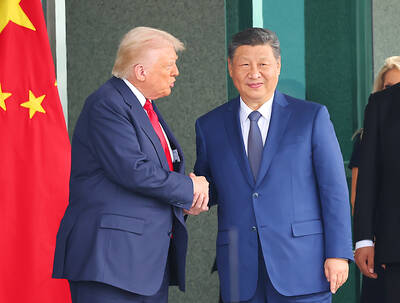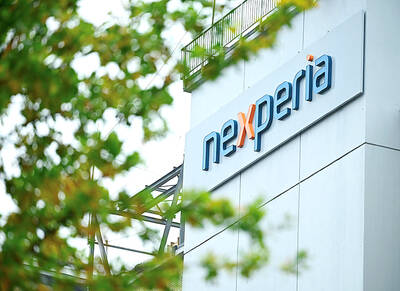HTC Corp (宏達電) is set to release several new devices in the second half of this year, including a new “selfie phone,” codenamed “Eye.”
The handest is set to be launched in the US in the fourth quarter, said a report published on Friday on technology news Web site eprice.com.
The HTC Butterfly 2, an Android-based, fourth-generation long-term evolution-capable smartphone designed and developed by the company, has already been certified in Japan.
The international version of the Butterfly 2 has received certification from Visa for contactless near-field communication payments, which enable mobile payments at point of sale, indicating that the device will be launched soon, the report said.
In addition, although a new variant of its flagship model, the HTC One (M8) has been available in China since the first half of the year, the official version of the device is soon to make its China debut after it received certification by the Chinese Ministry of Industry and Information Technology.
According to market speculation, HTC plans to launch its first handset compatible with the Windows Phone 8S operating system, the HTC W8, in the third quarter of this year.
Shipments of Taoyuan-based HTC’s smartphones doubled last quarter, as it has been gearing up to put out new models on the market, ranging from high-end to mid-range devices, researcher Digitimes Research said on Friday.
Overall shipments of Taiwanese phones in the quarter ended June 30 grew by about 30 percent from both a year earlier and a quarter earlier, driven by local brands’ intensive efforts to launch new models, the researcher said.
Taiwan shipped 21.06 million units during the April-to-June period, up 29.8 percent from the previous quarter and 30.2 percent from the same period a year ago, the researcher said.
Taipei-based Asustek Computer Inc (華碩) also saw strong shipments during the three-month period due to high sales of its low-cost Zenfone series, it added.
As for contract phone makers, both Chi Mei Communication Systems Inc (奇美通訊) and Compal Communications Inc (華寶) saw rising shipments on the back of orders for Sony smartphones and Nokia feature phones.
However, declining shipments from Arima Communications Corp (華冠通訊), which is another contract manufacturer, offset the overall growth among contract makers.

RUN IT BACK: A succesful first project working with hyperscalers to design chips encouraged MediaTek to start a second project, aiming to hit stride in 2028 MediaTek Inc (聯發科), the world’s biggest smartphone chip supplier, yesterday said it is engaging a second hyperscaler to help design artificial intelligence (AI) accelerators used in data centers following a similar project expected to generate revenue streams soon. The first AI accelerator project is to bring in US$1 billion revenue next year and several billion US dollars more in 2027, MediaTek chief executive officer Rick Tsai (蔡力行) told a virtual investor conference yesterday. The second AI accelerator project is expected to contribute to revenue beginning in 2028, Tsai said. MediaTek yesterday raised its revenue forecast for the global AI accelerator used

Taiwan Semiconductor Manufacturing Co (TSMC, 台積電) has secured three construction permits for its plan to build a state-of-the-art A14 wafer fab in Taichung, and is likely to start construction soon, the Central Taiwan Science Park Bureau said yesterday. Speaking with CNA, Wang Chun-chieh (王俊傑), deputy director general of the science park bureau, said the world’s largest contract chipmaker has received three construction permits — one to build a fab to roll out sophisticated chips, another to build a central utility plant to provide water and electricity for the facility and the other to build three office buildings. With the three permits, TSMC

TEMPORARY TRUCE: China has made concessions to ease rare earth trade controls, among others, while Washington holds fire on a 100% tariff on all Chinese goods China is effectively suspending implementation of additional export controls on rare earth metals and terminating investigations targeting US companies in the semiconductor supply chain, the White House announced. The White House on Saturday issued a fact sheet outlining some details of the trade pact agreed to earlier in the week by US President Donald Trump and Chinese President Xi Jinping (習近平) that aimed to ease tensions between the world’s two largest economies. Under the deal, China is to issue general licenses valid for exports of rare earths, gallium, germanium, antimony and graphite “for the benefit of US end users and their suppliers

Dutch chipmaker Nexperia BV’s China unit yesterday said that it had established sufficient inventories of finished goods and works-in-progress, and that its supply chain remained secure and stable after its parent halted wafer supplies. The Dutch company suspended supplies of wafers to its Chinese assembly plant a week ago, calling it “a direct consequence of the local management’s recent failure to comply with the agreed contractual payment terms,” Reuters reported on Friday last week. Its China unit called Nexperia’s suspension “unilateral” and “extremely irresponsible,” adding that the Dutch parent’s claim about contractual payment was “misleading and highly deceptive,” according to a statement